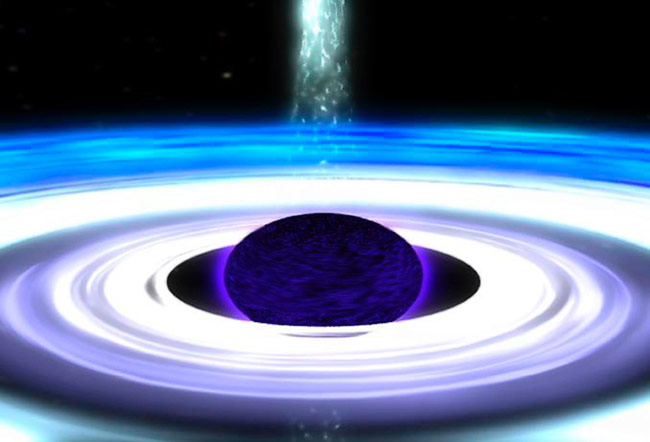Early Black Holes May Have Heated the Universe

Though invisible, big black holes are not hard to find. Astronomers have noted evidence in the center of many galaxies for supermassive black holes weighing millions to billions of times our Sun.
Where these huge holes came from is an open question. One theory is that they are the result of a progressive build-up of smaller black holes, starting from the stellar mass black holes that formed from the explosions of the first stars.
If this hierarchical formation is true, then some of the middle stages between the 10-solar-mass acorns and the billion-solar-mass oaks should still be around. Yet confirmation of these intermediate mass black holes has been difficult to come by.
"People look very hard for intermediate mass black holes, but it's not easy, and there have only been marginal detections," says Martin Haehnelt of Cambridge University.
But there may be indirect evidence for these middleweight black holes in the re-warming of the early universe.
"Matter accreting around a black hole heats up," Haehnelt said, "and this heating could be a sign that small black holes were widespread in the universe at that time."
Haehnelt presented a model for these primordial heaters on April 13 at the Institute of Physics conference Physics 2005 in Warwick, England.
Breaking space news, the latest updates on rocket launches, skywatching events and more!
Renaissance
In general, the gas in the universe has cooled over time due to expansion. But more than 13 billion years ago, the cosmos awoke out of its dark age with the emergence of the first stars. These earliest beacons of light are thought to have warmed the surrounding gas.
However, a detailed map of the cosmic microwave background showed that the gas heating - called reionization - occurred earlier than expected. The implication may be that other sources - like medium-sized black holes - contribute.
"Black holes have an easier time doing the re-warming than stars because their photons are more energetic," Haehnelt told SPACE.com.
The first black holes would originate out of the ashes of the first massive stars. Like more massive quasars, these gravitational monsters would generate light by exciting gas that falls into their gaping maws. This light would have heated, or reionized, most of the gas in the universe.
Models for reionization are loaded with uncertainties, so it is not clear that intermediate mass black holes are actually necessary to make it all work. But there may be a way to confirm their existence in the gravitational shouts from their growing pains.
Merging signals
Besides gas accretion, black holes grow in size by merging. When two black holes spiral into each other, the final titanic clap sends out gravity waves - undulations in the fabric of space-time.
If there was an early population of medium-sized black holes, their mergers might be observable as observatories are employed to look at the farthest reaches of space and, therefore, way back in time.
"They could potentially be a very significant source of gravitational waves," said Andrew Zentner of the University of Chicago.
Zentner and Savvas Koushiappas of the Swiss Federal Institute of Technology Zurich have studied what might be learned about the first black holes from the proposed Laser Interferometric Space Antenna (LISA), which is a set of space-born gravity wave detectors, scheduled for launch in 2012.
LISA could probably not detect any of the early mergers directly, but it may see a background, or "glow," in gravity waves from the whole history of mergers. This signal could tell researchers how big were the seeds of the supermassive black holes.
"If you turn on LISA and see nothing, it would imply that mergers are not the most important mechanism for creating supermassive black holes," Zentner said.
The alternative might be that big black holes are just born big - forming when a giant cloud of gas collapses in the center of a galaxy. In this way, supermassive black holes would skip an infant and adolescent stage entirely.
- Missing Black Holes Found
- Runaway Star Collisions Create Black Holes
- 'Astounding' Findings Pin Down Age of Universe, Birth of First Stars
- Hubble Spots Ten Supermassive Black Hole

Michael Schirber is a freelance writer based in Lyons, France who began writing for Space.com and Live Science in 2004 . He's covered a wide range of topics for Space.com and Live Science, from the origin of life to the physics of NASCAR driving. He also authored a long series of articles about environmental technology. Michael earned a Ph.D. in astrophysics from Ohio State University while studying quasars and the ultraviolet background. Over the years, Michael has also written for Science, Physics World, and New Scientist, most recently as a corresponding editor for Physics.
